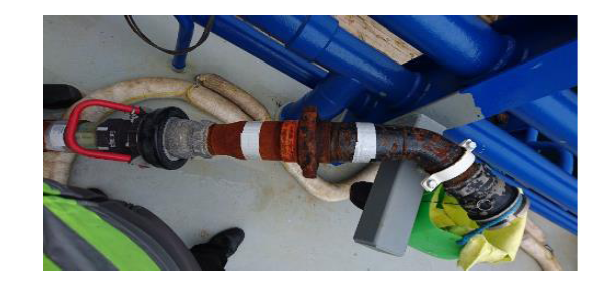The Marine Safety Forum has published a safety alert regarding a minor fuel spill during offshore fuel transfer.
A platform supply vessel (PSV) was on location ready to deliver fuel, and the hose was connected. Crew were posted nearby on watch. The pump was started on a low rate in order to prove the line with the installation. Very shortly after starting the pump a spray of fuel was noticed from another fuel connection – not the one in use on this occasion. Bunkering operations were stopped immediately. Less than 1 litre of fuel was estimated to have escaped to sea.
Causes:
On this occasion the leak originated form the Port aft connection. This connection was not part of the vessels fixed pipework system, but a removable flexible hose connected to the port mid-ships manifold, leading aft to the port quarter. The hose was terminated with a dry break connection, which was capped at the time of the incident, the valve at the port mid-ships manifold was thought to be closed at the time of the incident.
For this spill to occur, the port mid-ships manifold valve and the dry-break connection had to be passing. After stopping the pumping operation, the ABs disconnected the flexible hose double checked the valve and replaced the cap on the mid-ships manifold. The fuel transfer was then completed without further incident.
The subject vessel, as with many PSVs has a common fuel system and as such when the fuel line is in use, the whole line is pressurised, not just the line to the working manifold. In short, all manifolds on a given system are under the same pressure as the working manifold.
Recommendations
This incident serves as a good reminder that all connections (not just the ones in use) need to be checked prior to commencing bulk transfer operations.
- All valves should be correctly closed with appropriate caps in place and correctly fitted.
- Regular maintenance and inspections of manifold valves and connections are an important factor in preventing spills of this type.
- After this incident the flexible hose was removed and replaced with fixed pipework, the manifold valve inspected and the dry-break connection replaced.
- It is suspected that the location of the manifold valve may have been a factor on this occasion, its position, potentially making it difficult to access and effectively operate.
- It was recommended to the vessel owner that a gearbox/wheel assembly be fitted, in order to aid effective operation of the valve.
Source & Image credit: IMCA Safety Flash

































































